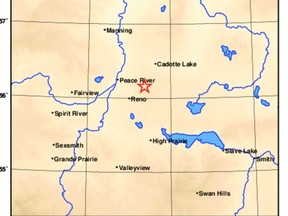Magnitude 5.58 earthquake in northern Alberta makes waves

Article content
A record-breaking earthquake recorded in northern Alberta made waves across the province and has attracted interest from scientists beyond.
On Tuesday evening, Earthquakes Canada reported an earthquake with a magnitude of 5.8, a depth of two kilometres and an epicentre about 356 kilometres northwest of Edmonton, where some residents reportedly felt the seismic event.
It followed a smaller, 5.2-magnitude quake in the area a little over an hour earlier, but both were recorded within a 30-kilometre radius of Reno, a hamlet about 45 kilometres southeast of Peace River.
The larger earthquake was first reported with a magnitude of 6.0, but the Alberta Geological Survey’s earthquake dashboard reports the magnitude as 5.58, which still makes it the largest recorded earthquake in the province, seismologist Ryan Schultz told Postmedia in an interview.
“Previously, the largest earthquake recorded in Alberta was 5.4 in 2001 at Dawson Creek,” said Schultz, who has studied Alberta earthquakes and is completing a PhD in geophysics at Stanford University in California.
As of Wednesday evening, Earthquakes Canada’s community intensity map, which crowdsources earthquake experiences from the public, saw 335 responses from as far north as High Level, about 300 kilometres north of the epicentre, to Calgary, about 750 kilometres southeast of the site.
The Peace River area is known for seismic activity, but the size of the larger quake was surprising to Jeff Gu, a professor of geophysics at the University of Alberta, because earlier earthquakes in the area have generally been smaller.
“It is starting to creep into potentially damaging magnitudes — magnitude six or above,” Gu said. “High fives are certainly large enough to be a cause for concern.”
However, Gu added, additional study of the larger quake over the coming days may yield more refined results in terms magnitude, location and timing.
Schultz said scientists like himself are interested in studying the larger quake to better understand whether it had natural or induced (i.e. human) causes.
“If it’s natural, then this is essentially just something you have to live with — it’s just a fact of that natural process that’s ongoing,” he said. “But if it is induced, then there’s potentially something that can be done about that.”
While natural earthquakes are more common for residents of places such as B.C. and California, they’re not unheard of in Alberta, Schultz said.
Subducting plates in B.C., underneath North America’s continental plate, can push and force the landmass, Schultz said, which causes stress that can be transmitted over 1,000 kilometres away in Alberta.
“This stress and strain that’s being accumulated from this process does get released occasionally through something called an earthquake — you have a fault somewhere and that quickly slips, releasing that energy,” he said.
However, the majority of the earthquakes that occur in Alberta are induced, Schultz said.
“They’re caused by people — by either fracking operations, disposal operations or production operations in the oil and gas industry, and there’s been a long recorded history of earthquakes related to that,” he said.
— With files from Anna Junker






Postmedia is committed to maintaining a lively but civil forum for discussion. Please keep comments relevant and respectful. Comments may take up to an hour to appear on the site. You will receive an email if there is a reply to your comment, an update to a thread you follow or if a user you follow comments. Visit our Community Guidelines for more information.